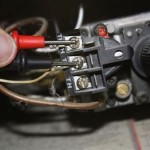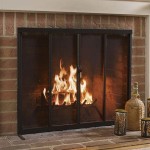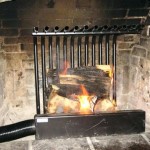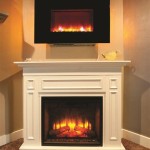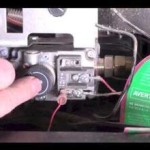Can You Put A Fireplace In An Existing House?
The addition of a fireplace to an existing house is a consideration for many homeowners seeking to enhance the ambiance, increase property value, or provide supplemental heating. While it is generally possible to install a fireplace in a house that wasn't originally built with one, the process is not without its complexities. Numerous factors must be assessed and addressed to ensure a safe and compliant installation. This article will outline the key considerations involved in adding a fireplace to an existing home.
The feasibility of installing a fireplace depends on the house's structural design, existing building codes, and the type of fireplace desired. Early planning and consultation with qualified professionals, such as architects, structural engineers, and certified fireplace installers, are crucial for a successful project.
Structural Considerations and Requirements
The structural integrity of the house is paramount when planning to add a fireplace. A primary concern is whether the existing floor can support the weight of the fireplace and its associated chimney. Traditional masonry fireplaces, constructed of brick or stone, are exceptionally heavy, often weighing several tons. This weight requires a strong foundation capable of bearing the load without compromising the structural stability of the house.
If the existing floor is not adequately reinforced, structural modifications will be necessary. This may involve reinforcing the floor joists, adding support columns, or even constructing a dedicated foundation for the fireplace. A structural engineer can assess the load-bearing capacity of the floor and recommend the appropriate reinforcement measures. These modifications can add significantly to the overall cost and complexity of the project.
Another structural consideration involves the pathway for the chimney. A chimney needs a clear, unobstructed route from the fireplace to the exterior of the house, extending above the roofline. Ideally, the chimney should be positioned in a location where it can pass through existing walls and floors with minimal disruption to the house's structure. However, in many existing homes, this is not always possible. Walls may need to be opened, floors cut, and framing modified to accommodate the chimney. These alterations must be performed by qualified contractors and in compliance with local building codes.
The required clearances to combustible materials are also crucial. Building codes mandate specific distances between the chimney and any nearby flammable materials, such as wood framing, insulation, or roofing materials. These clearances are designed to prevent the risk of fire caused by the heat radiating from the chimney. Failing to adhere to these clearances can result in a dangerous fire hazard and code violations.
In some cases, a direct-vent fireplace may be considered. Direct-vent fireplaces use a sealed combustion system that draws air from outside the house and vents exhaust gases directly to the exterior through a coaxial pipe. This system eliminates the need for a traditional chimney, simplifying the installation process and reducing the structural impact on the house. However, direct-vent fireplaces still require careful planning and adherence to manufacturer's instructions to ensure safe and proper operation.
Assessing Building Codes and Regulations
Building codes and regulations play a significant role in determining the feasibility and requirements for installing a fireplace. Compliance with these codes is essential for ensuring the safety of the installation and avoiding potential legal issues. Local building departments enforce these codes and typically require permits for fireplace installations. Obtaining the necessary permits involves submitting detailed plans and specifications for the project and undergoing inspections to verify compliance with the applicable codes.
Fireplace installations are governed by various codes, including the International Residential Code (IRC), the National Fire Protection Association (NFPA) standards, and local building codes. These codes specify requirements for chimney construction, fireplace clearances, venting systems, and fire safety features. It is crucial to familiarize oneself with these codes or consult with a qualified professional familiar with local regulations.
One critical aspect of building codes is the regulation of hearth extensions. The hearth extension is the non-combustible area that extends outward from the front and sides of the fireplace opening. Its purpose is to protect the flooring from sparks and embers that may escape from the fireplace. Building codes specify the minimum dimensions of the hearth extension based on the size of the fireplace opening. Failure to provide an adequate hearth extension can create a fire hazard and result in code violations.
Energy efficiency requirements are also increasingly incorporated into building codes. These requirements may pertain to the insulation of the fireplace and chimney, the use of airtight doors, and the overall efficiency of the combustion process. Meeting these requirements can help reduce energy consumption and improve the energy performance of the house.
In addition to building codes, local zoning regulations may also impact the installation of a fireplace. Zoning regulations may dictate restrictions on the placement of chimneys, the height of structures, and other aspects of the project. Before commencing any work, it is advisable to consult with the local zoning department to ensure compliance with all applicable regulations.
Choosing the Right Type of Fireplace
Several types of fireplaces are available, each with its own advantages and disadvantages. The selection of the appropriate fireplace depends on factors such as the budget, aesthetic preferences, heating requirements, and the existing infrastructure of the house. The most common types of fireplaces include:
Wood-burning Fireplaces: Traditional wood-burning fireplaces offer a classic ambiance and the warmth of a natural fire. However, they are also the least efficient type of fireplace, with a significant amount of heat lost up the chimney. Wood-burning fireplaces require a substantial chimney system and a reliable source of dry firewood. They also produce smoke and creosote, which can pose air quality and fire safety concerns if not properly maintained. Installing a wood-burning fireplace in an existing house can be more challenging due to the need for a robust chimney and compliance with stricter emissions regulations.
Gas Fireplaces: Gas fireplaces offer convenience and ease of use. They can be fueled by natural gas or propane and can be ignited with the flip of a switch or the press of a button. Gas fireplaces are generally more efficient than wood-burning fireplaces and produce less pollution. They are also easier to maintain, requiring less cleaning and maintenance. Gas fireplaces can be vented through a traditional chimney or a direct-vent system, offering greater flexibility in installation. However, a gas line needs to be run to the fireplace location, which may require professional plumbing work.
Electric Fireplaces: Electric fireplaces are the simplest to install and require no venting or fuel lines. They plug into a standard electrical outlet and produce heat using electric resistance. Electric fireplaces are typically less expensive than wood-burning or gas fireplaces and are ideal for supplemental heating in small spaces. They offer realistic flame effects and can create a cozy ambiance. However, they do not provide the same level of heat as other types of fireplaces and may increase electricity consumption.
Ethanol Fireplaces: Ethanol fireplaces burn denatured alcohol, which produces a clean-burning flame without the need for a chimney or venting. They are relatively easy to install and can be used in a variety of settings. Ethanol fireplaces offer a modern and stylish aesthetic. However, they produce less heat than other types of fireplaces and require a constant supply of ethanol fuel. Safety is a primary consideration with ethanol fireplaces, as spills and improper use can create a fire hazard.
The choice of fireplace type should be carefully considered in consultation with a qualified fireplace installer. The installer can assess the specific needs and requirements of the project and recommend the most appropriate type of fireplace based on factors such as budget, heating requirements, and aesthetic preferences.
Adding a fireplace to an existing house can significantly enhance its aesthetic appeal and provide supplemental heating. However, it is a complex project that requires careful planning, structural assessment, and adherence to building codes. By addressing the structural considerations, complying with building regulations, and selecting the right type of fireplace, homeowners can successfully add a fireplace to their existing home and enjoy the warmth and ambiance it provides.

Adding A Fireplace To Existing Home Where For Fireplaces

Adding A Gas Fireplace To An Existing Home Just Log Fires

Your Home Doesn T Have A Fireplace And You Want To Add One

Adding A Fireplace Is It Actually Possible Home Sweet Homes

Installing A New Fireplace Albers Fire Places

How To Add A Gas Fireplace An Existing Home

Adding A Fireplace Is It Actually Possible Home Sweet Homes

Fireplace Additions Answers On

Adding A Fireplace Is It Actually Possible Aj Development Llcblog

Fireplace Insert Guide Fireplaces Direct Learning Center

